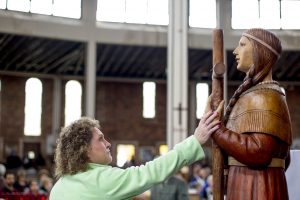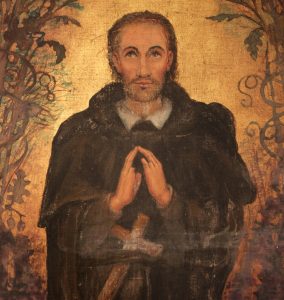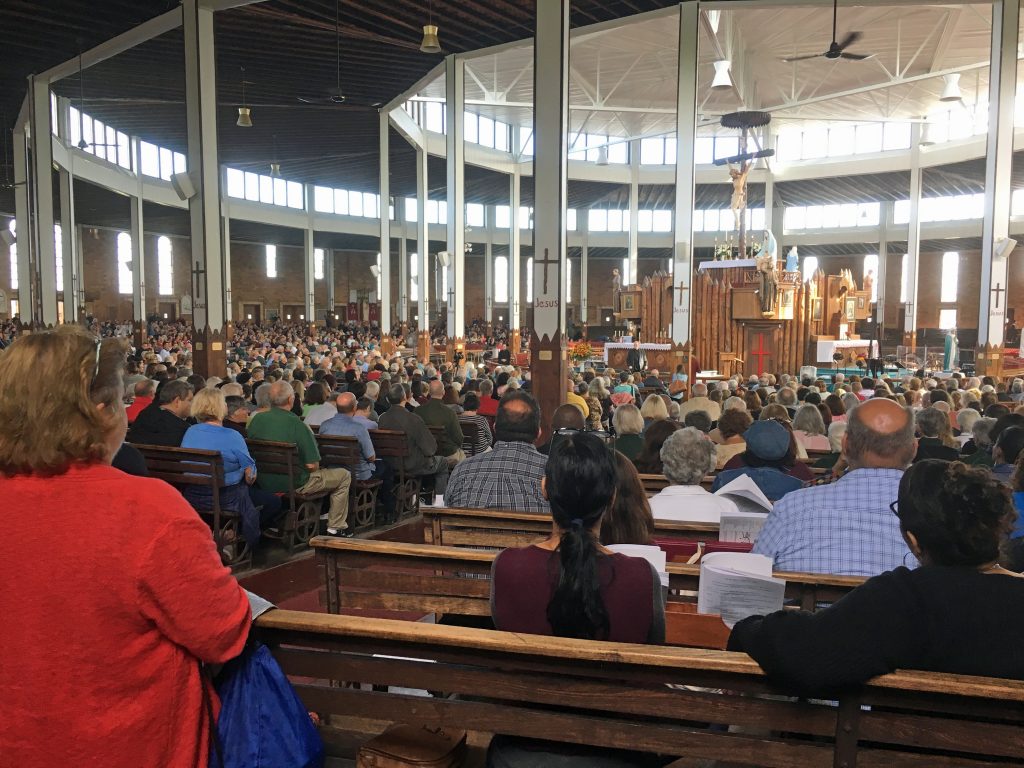Auriesville, New York — I recently spent the Oct. 19 feast day of the North American Martyrs trampling through the fall foliage on the grounds of the shrine dedicated in their honor here in upstate New York. It is believed to be here, as well as a bit north over the Canadian border, where St. Isaac Jogues and some other Jesuit martyrs were killed for their Faith.
I often wonder why more of us, especially on the East Coast, do not spend more time up here.
There’s a famous quote from the early Christian writer Tertullian about the blood of the martyrs being the seed of the Church. Well, we all know our Church needs renewal right now, right?
Perhaps part of the reason this isn’t the No. 1 pilgrimage destination in the U.S. has to do with the political incorrectness, so to speak, on the surface of the story: Indians being brutal to European missionaries. It doesn’t help that missionary work here was often caught up in the culture of colonialism of that time.
But being here, in upstate New York, less than an hour from the statehouse in Albany — where a Catholic governor expanded legal abortion and lessened protections for women and innocent human life — one of the messages of this place is clear: Brutality takes many forms.
There are innocents being martyred still, and not just a world away. Learning from and honoring this history requires humility and imagination of the kind that the founder of the Jesuits, St. Ignatius Loyola, was known for fostering through his “Spiritual Exercises.”
These grounds are also believed to have been the birthplace of St. Kateri Tekakwitha, who was a young convert and a holy example of purity and innocence. Do not so many of us need protection and restoration in this hyper-sexualized culture that does so much harm to the body, mind, and soul?
I visited her tomb, just about a 15-minute car ride from the Montreal airport. The place is another powerhouse of prayer. If a little church can radiate courage, the resting place of her earthly remains there does that.
I ended up in a taxi with a Mohawk driver who told me that his grandmother was at Kateri’s canonization Mass (she is descended from both Algonquins and Mohawks) and got to meet Pope Benedict XVI on the occasion.
The story was a source of pride for this man’s family, but for me it was a reminder that saints are closer to us than we sometimes think, both geographically and supernaturally.

Saint Benedict Press recently published a book I curated called “A Year with the Mystics: Visionary Wisdom for Daily Living.”
I will forever be grateful that I had the opportunity to put it together because it meant spending a whole lot more time than usual with so many holy people who wrote of their journey to union with God, which is what mysticism is, and it’s something we’re all called to.
Because the book is not “Two Years with the Mystics” and the large majority of the book’s meditations are from people who are either canonized or are on the road to canonization, this reflection from Swiss theologian and mystic Father Maurice Zundel fell to the cutting room floor:
“The attraction exercised by God is like a magnet, like the process of magnetization. We begin to exist, to be free, to be persons when we respond to this divine magnetization; then we begin to be saints. In the case of saints, the magnetization happens at a closer range, saints cling to the magnet more continuously. And we clearly feel that in Jesus’ humanity there is no longer any distance between it and the magnet. It no longer escapes the attraction of grace. It is projected into God with a force that is God. It is carried, lifted by the magnet.”
The more we spend time with Christ in prayer, in front of the Blessed Sacrament, and with people who do the same, the more we will be his love in the world, which is at the heart of sanctity.
Zundel explains an essential part of the process of sanctification:
“In Jesus Christ, there is a total renouncement to any clinging of self. If you prefer, from the point of view of his humanity, Jesus is the man who has lost his self. There is no longer any self. There is no longer any possibility for him to cling to his self, to oppose his self to God, because he is completely magnetized, lost in divinity and projected into God by this magnet which is God, because in God each Person is a whole-hearted movement toward the other.”
Jesus wants to draw us into his life, the life of the love of the Trinity. And when we pay attention to both our rich history of sanctity around us and the communion of saints who do not leave us alone, we see new possibilities for life, we live hope.
People see something different in our lives than what the world conventionally offers, and that’s what can lead them to grow in faith, hope, and love, too.
The good news for most of us is that you don’t have to be a priest or missionary to be a saint. In his 2018 apostolic exhortation, “Gaudete Et Exsultate” (“Rejoice and Be Glad”), Pope Francis writes:
“Rejoice and be glad” (Matthew 5:12), Jesus tells those persecuted or humiliated for his sake. The Lord asks everything of us, and in return he offers us true life, the happiness for which we were created. He wants us to be saints and not to settle for a bland and mediocre existence. The call to holiness is present in various ways from the very first pages of the Bible. We see it expressed in the Lord’s words to Abraham: ‘Walk before me, and be blameless’ ” (Genesis 17:1).
He said that his “modest goal” with the document is “to re-propose the call to holiness in a practical way for our own time, with all its risks, challenges and opportunities. For the Lord has chosen each one of us “to be holy and blameless before him in love” (Eph 1:4).
The Holy Father then emphasized that the cloud of witnesses to the glory of God can be all around us. They “may include our own mothers, grandmothers or other loved.” He added: “Their lives may not always have been perfect, yet even amid their faults and failings they kept moving forward and proved pleasing to the Lord.” How important this is!
In remembering the saints, we also remember we are not alone. This is real; we have intercessors in heaven. Heaven isn’t merely a Hallmark thought but a reward and a promise and an aid in battle here! In “Gaudete Et Exsultate,” Pope Francis quoted a homily from his predecessor, Pope Benedict XVI, delivered in 2005 upon becoming pope:
“I … can say with renewed conviction: I am not alone. I do not have to carry alone what in truth I could never carry alone. All the Saints of God are there to protect me, to sustain me and to carry me. And your prayers, my dear friends, your indulgence, your love, your faith and your hope accompany me. Indeed, the communion of Saints consists not only of the great men and women who went before us and whose names we know. All of us belong to the communion of Saints, we who have been baptized in the name of the Father, and of the Son and of the Holy Spirit, we who draw life from the gift of Christ’s Body and Blood, through which he transforms us and makes us like himself. Yes, the Church is alive.”
Each of us can say this! The Church is alive! We are not alone! We are very much a part of the renewal in the Church and the world. We each have our roles. We are called not to get mad or depressed, but to live this reality!

Coming back to the Auriesville shrine, it helps to understand the joy and spirit of forgiveness found in Jogues when you read his words:
“My hope is in God, who needs not us to accomplish his designs. We must endeavor to be faithful to him and not spoil his work by our shortcomings. I trust you will obtain me this favor of our Lord, that, having led so wretched a life till now, I may at last begin to serve him better.”
Jogues and the other Jesuit martyrs — they are our martyrs. Pray to them and your other patrons, for your life, for your family, for the Church, for our country.
The message of the feast of All Saints’ Day is this: We are not alone. Instead, we are “all in this together” with all the saints who from their labors rest, but who never leave us alone and instead spend eternity intervening to help us become saints!

